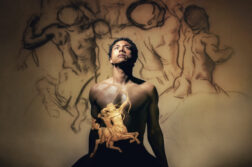“Self-Confidence and Persistence: Two Hundred Years of History”
Schwules Museum, Berlin
Exhibition and Catalog
(189 pages, 12.00 Euros)
BERLIN’S SCHWULES museum opened its permanent exhibition in December 2004, featuring 200 years of gay German history, 1770–1970. The German word schwul translates as “gay male” and excludes lesbians. Under the direction of the museum’s co-founder Andreas Sternweiler, the comprehensive new exhibit sums up a historical record compiled by twenty years of museum projects in western Germany.
The exhibit uses 55 organizing narratives, beginning with “Persecution before 1800” and ending with “East Germany—breaking new ground after 1970.” The first sections present medieval Europe’s punishments for sodomy. Fast forward to the 18th and 19th centuries, when interest in the topic centered on discussions of the ancients’ practice of pederasty, and hot classical gods with muscular, marble butts were installed in fountains or on pediments.
German homo-activism dates from the 1860’s with Karl Heinrich Ulrichs’s radical “Uranian” writings, which landed him in prison and in exile. Adolf Brand founded Der Eigene (“the Peculiar”), the first gay magazine, in 1898. Brand’s best known stunt was “outing” Reich’s Chancellor Franz von Bülow in 1907, which garnered Brand eighteen months in prison. There was considerable conflict among some of the early pioneers, with Brand often at odds with Magnus Hirschfeld, who co-founded the Wissenschaftlich-humanitäres Komitee (Scientific Humanitarian Committee) or WhK in 1897. While Hirschfeld believed that homosexuals constitute a “third sex,” Brand upheld a hyper-masculine ideal for homosexual men and ridiculed his rival for championing “sissy boys.”
The WhK, which the Schwules Museum dubs the “the world’s first gay self-help organization,” sponsored public lectures about the “third sex,” trained police to tolerate same-sex cabarets and balls, provided financial and legal assistance for sex radicals in trouble with blackmailers or the law, and petitioned against the infamous paragraph 175, which outlawed sodomy. Hirschfeld supported female prostitutes and unwed mothers (though this is not discussed in the exhibit), and in 1919 he founded the Institute for Sexology (ISS), in many respects the institutional prototype for this new museum in Berlin.





